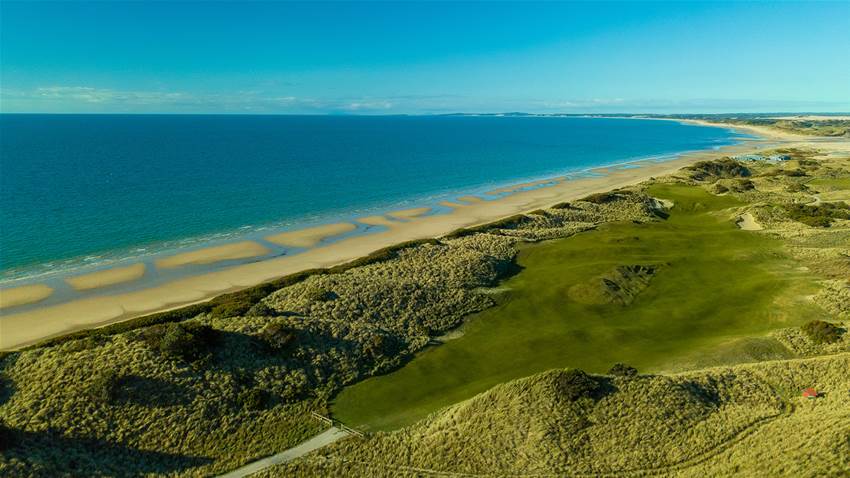The best long two-shotters test a player’s ability to execute a pair of classy long shots. At the same time, they show off interesting strategies most often built around a green benefiting a shot played from a particular part of the fairway.
THE DUNES GL
409-metre, 1st hole
It’s rare to be faced with the hardest hole of a round from the opening tee shot but that is what you’ll find at The Dunes. A driving line left of the cypress tree in the distance is recommended as this will give you a good look at the green. If you cut the corner of the right dogleg you had better be long to avoid the hidden bunkers. It’s a tough green too, with cavernous bunkers and a deep swale in front.

THE DUNES GL
431-metre, 15th hole
This is a beast of a hole from the tips as well as the shorter medal tees (392 metres). It covers brilliant rolling terrain wedged between high dunes, with the dune to the right home to a massive blowout bunker. If you are long enough you can ride the slopes and get to the bottom of the hill. The percentage approach shot is not aimed to the middle of the green but to the left bank, which will feed the ball back to the centre of the wide putting surface.
THE NATIONAL GC – GUNNAMATTA COURSE
405-metre, 4th hole
The bones of the 16th hole of the old Ocean Course form the basis of Tom Doak’s 4th hole creation. The fairway was widened slightly to the left just before it turns gradually right around a vast sandy wasteland area. The hole was lengthened with a new green being built among the natural contours near the old 17th tee.
THE NATIONAL GC – GUNNAMATTA COURSE
402-metre, 18th hole
In the Tom Doak redesign, this hole was shortened by nearly 40 metres while the fairway was widened to provide a better view for shorter hitters playing to the left half of the fairway. The green was also reshaped to give it more width and provide more pin positions.

THE NATIONAL GC – MOONAH COURSE
394-metre, 3rd hole
The drive, one of the most exhilarating at The National, is played from an elevated dune through a narrow opening in the Moonah trees to a plateau landing area, which is flanked by more dunes. The fairway falls to the right before riding a wave of undulations to the green.
THE NATIONAL GC – MOONAH COURSE
447-metre, 16th hole
A great driving hole, either from the tips or the slightly shorter blue tees. Four deep bunkers – two left and two right – line the driving zone and are very much in play with any crosswind. Contours at the back of the green are favourable for shots played with longer clubs so take enough club to carry the journey.
THE NATIONAL GC – OLD COURSE
358-metre, 15th hole
The wind is usually into the face as you stand on the tee here. Drives short of the dogleg corner leave blind second shots to a green with two clearly defined terraces.
The task of club selection to find the correct level, is exacerbated by deep bunkers front and rear.

VICTORIA GC
398-metre, 5th hole
Beautifully rejuvenated by the OCCM design team in recent times, the avenue between tee and green has been widened with the removal of scrub and exposure of the sandy wasteland, which now lines both sides of the hole and creates a barrier between the short grass and the trees. A wonderful green complex awaits, with three bunkers cut well into the putting surface.
VICTORIA GC
370-metre, 11th hole
Like the 5th hole, the gradual uphill 11th has been shined up like a diamond from a lump of coal through the OCCM redesign. There’s plenty of sand to be found en route to the green, but the trickiest bunker recoveries are closer to the green.
VICTORIA GC
402-metre, 12th hole
Geoff Ogilvy describes the tee shot at the 12th as the “most dramatic on the course”, where you play left of the recently exposed indigenous plants on the right because there is plenty of room there. The downhill second shot is ‘semi-blind’ for all players except those who have hit 300-metre plus drives.

WOODLANDS GC
400-metre, 10th hole
A good straight drive can reach the crest of a hill some 200 metres away. The approach must be accurate as there is thick woodland on both sides of the fairway, and heavy bunkering protecting this small green, which slopes away from left-to-right. Cross bunkers 40 metres in front of this green catch anything short.
YARRA YARRA GC
400-metre, 2nd hole
One of Yarra Yarra’s tougher two-shotters, a long tee shot is needed to set up a straightforward second shot to an elevated green. The difficult second shot, played from a downslope, will require a decision on whether to attempt to carry the bunkers 40 metres short of the green or to lay-up. In all, there are five bunkers left and short of the green, while another four can be found to the right.

YARRA YARRA GC
371-metre, 7th hole
The Renaissance Golf Design renovation added some width to the fairway here but longer hitters can be caught out by a scheme of bunkers that pinch into the fairway from the right. As is the case with all good strategic holes, the best angle into the green is from alongside the bunkers as the putting surface slopes from left to back right. The left greenside bunker is problematic with the flag on the left, while the back right bunker catches balls that feed naturally with the slope of green.
Related Articles

Barnbougle Dreamin': They built it, they came, they're still coming

19 Holes With... Cameron Daddo













